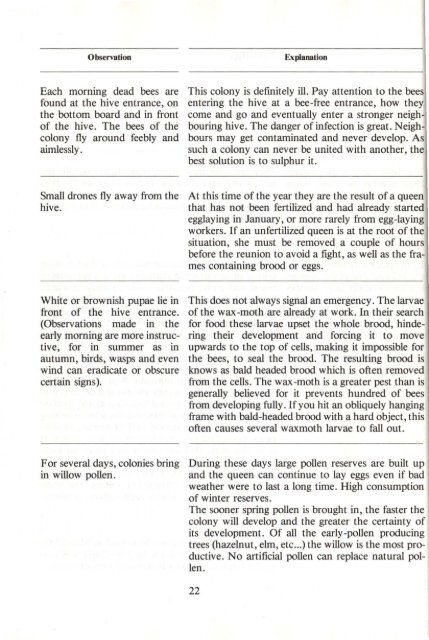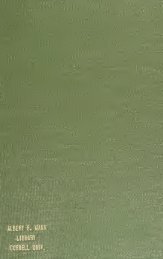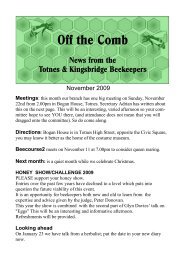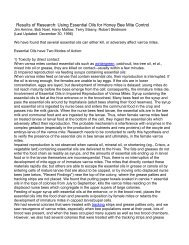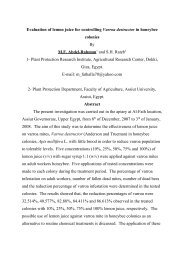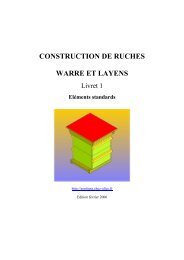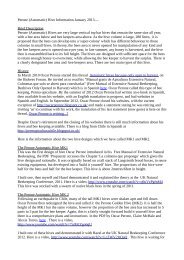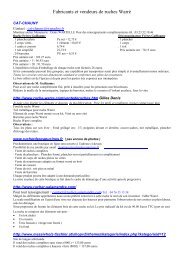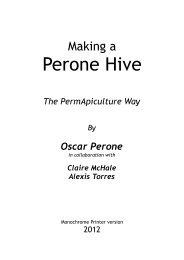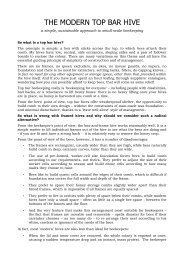Create successful ePaper yourself
Turn your PDF publications into a flip-book with our unique Google optimized e-Paper software.
Observation<br />
Explanation<br />
Each morning dead bees are<br />
found at <strong>the</strong> hive entrance, on<br />
<strong>the</strong> bottom board and in front<br />
of <strong>the</strong> hive. The bees of <strong>the</strong><br />
colony fly around feebly and<br />
aimlessly.<br />
Small drones flyaway from <strong>the</strong><br />
hive.<br />
This colony is definitely ill. Pay attention to <strong>the</strong> bees<br />
entering <strong>the</strong> hive at a bee-free entrance, how <strong>the</strong>y<br />
come and go and eventually enter a stronger neighbouring<br />
hive. The danger of infection is great. Neighbours<br />
may get contaminated and never develop. As<br />
such a colony can never be united with ano<strong>the</strong>r, <strong>the</strong><br />
best solution is to sulphur it.<br />
II<br />
<strong>At</strong> this time of <strong>the</strong> year <strong>the</strong>y are <strong>the</strong> result of a queen<br />
that has not been fertilized and had already started<br />
egglaying in January, or more rarely from egg-laying<br />
workers. If an unfertilized queen is at <strong>the</strong> root of <strong>the</strong><br />
situation, she must be removed a couple of hours<br />
before <strong>the</strong> reunion to avoid a fight, as well as <strong>the</strong> frames<br />
containing brood or eggs.<br />
White or brownish pupae lie in<br />
front of <strong>the</strong> hive entrance.<br />
(Observations made in <strong>the</strong><br />
early morning are more instructive,<br />
for in summer as in<br />
autumn, birds, wasps and even<br />
wind can eradicate or obscure<br />
certain signs).<br />
For several days, colonies bring<br />
in willow pollen.<br />
This does not always signal an emergency. The larvae<br />
of <strong>the</strong> wax-moth are already at work. In <strong>the</strong>ir search<br />
for food <strong>the</strong>se larvae upset <strong>the</strong> whole brood, hindering<br />
<strong>the</strong>ir development and forcing it to move<br />
upwards to <strong>the</strong> top of cells, making it impossible for<br />
<strong>the</strong> bees, to seal <strong>the</strong> brood. The resulting brood is<br />
knows as bald headed brood which is often removed<br />
from <strong>the</strong> cells. The wax-moth is a greater pest than is<br />
generally believed for it prevents hundred of bees<br />
from developing fully. If you hit an obliquely hanging<br />
frame with bald-headed brood with a hard object, this<br />
often causes several waxmoth larvae to fall out.<br />
--------------------------- 111<br />
During <strong>the</strong>se days large pollen reserves are built up<br />
and <strong>the</strong> queen can continue to lay eggs even if bad<br />
wea<strong>the</strong>r were to last a long time. High consumption<br />
of winter reserves.<br />
The sooner spring pollen is brought in, <strong>the</strong> faster <strong>the</strong><br />
colony will develop and <strong>the</strong> greater <strong>the</strong> certainty of<br />
its development. Of all <strong>the</strong> early-pollen producing<br />
trees (hazelnut, elm, etc ... ) <strong>the</strong> willow is <strong>the</strong> most productive.<br />
No artificial pollen can replace natural pollen.<br />
22


